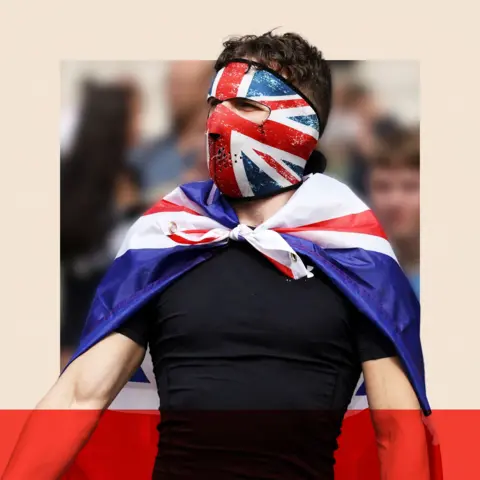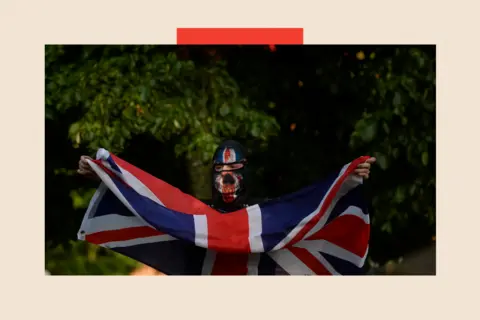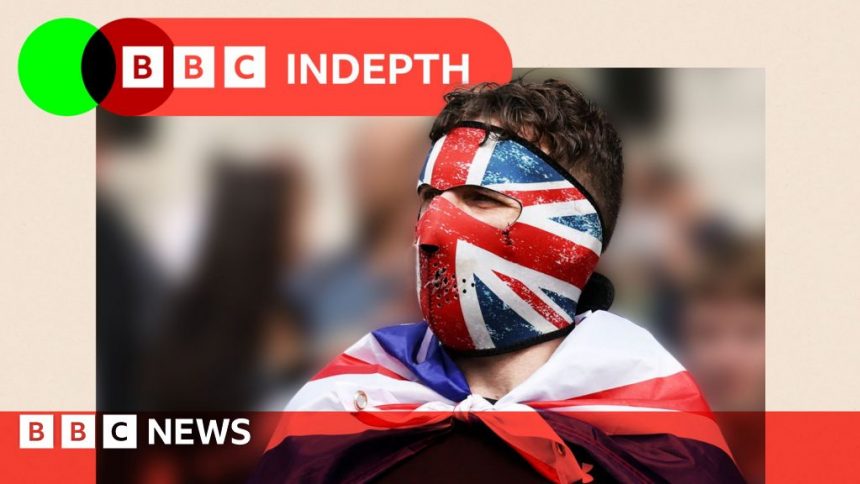Riots show how the UK’s far right has changed
 BBC
BBCThree weeks on from the start of the riots, many of us are still trying to make sense of their impact.
Will the disorder come to be seen as a one-off outburst quickly faced down by the public and police, or as a display of power by a newly dangerous far right?
The murders in Southport of Elsie Dot Stancombe, Alice da Silva Aguiar and Bebe King were seized upon by extremists, who exploited the tragedy to promote their own hatreds and agendas.
Online lies and misinformation inflamed the situation and some key instigators used social media and messaging apps to spread hatred and call for protests at fixed times and places.
The result was a series of violent flash mobs, spanning over several days, with racial and religious hatred the central animating motive. Mobs attacked hotels housing migrants, tried to set the buildings alight and pulled people from their cars.
The riots have been characterised as “far right” by public figures from the prime minister downwards. For many people, this description suggests the disorder was somehow organised by named, specific, formal groups or political parties; and the far right’s history of protest and violence by organisations like the National Front reinforces this idea.
As someone who has spent years investigating right-wing extremism, I keep being asked who organised the chaos, as if there is one simple answer.
But the recent disorder is more complex and has laid bare the anarchy of modern right-wing extremism, as well as the extent of its reach.
The truth is that no one organisation owned or organised the riots: they were bigger than that.
 PA
PAThis lack of cohesion makes the situation more unpredictable and dangerous. For the authorities, there are so many potential rioters and potential targets, and a lack of obvious national organisations to disrupt.
By contrast, counter-demonstrations by anti-racism campaigners have been far more cohesive and organised.
Right-wing extremism itself can be thought of a spectrum, rather than a coherent whole. It includes genocidal neo-Nazis treated as terrorists by the state, who hide behind online aliases, scorn campaigning, want to destroy society and venerate Adolf Hitler. But the term is also used to describe people who stand in democratic elections, engage in public campaigns and put forward policy platforms.
I tend to use “extreme right” for the first type and “far right” for the latter.
There are hatreds that unite different parts of the spectrum, but there are also differences. For example, the central antisemitic conspiracy theories espoused by neo-Nazis will not always be shared by some far-right figures, who might mainly target Muslims.
In key respects, right-wing extremism in the UK today has moved beyond being driven mainly by organisations and parties to instead being composed of looser networks of people, typically coalescing online.
There is no neo-fascist political party achieving electoral success in the way the British National Party (BNP) did in the recent past.
Today, there are no prominent political leaders as we’d traditionally understand them, either. The anti-Islam activist Tommy Robinson, real name Stephen Yaxley-Lennon, is probably the best-known public figure – but the convicted criminal oversees a personality cult rather than a coherent movement, with the endless spectacle of his online diatribes and legal issues providing a living soap opera.
Groups like the BNP and National Front still exist, but they are ghosts of their former selves, populated by older fascists and lacking appeal to younger people.
Newer, more extreme organisations have been created by younger people in the UK but the key examples – including the neo-Nazi groups National Action and Sonnenkrieg Division – have been outlawed by the government as terrorist organisations and disrupted by anti-fascists, journalists and the police.
Some right-wing extremists have moved away from setting up formal groups that draw attention from the police and have instead have sought to create looser networks, particularly online, where anyone can follow extremist channels or influencers.
For instance, some have formed in small groups like Patriotic Alternative (PA) and a network of fighting clubs in which white men meet to engage in violent training. These have adopted less overtly extreme rhetoric than organisations that have been banned, but contain similar people, and some PA members have been convicted of terrorism and racial hatred offences.
When violence occurs, it does not always come from the neo-Nazi end of the spectrum, nor are those responsible necessarily long-term extremists.
Most of those who took part in the disorder had no known links to the extreme or far right. There were a range of people involved, from people in their late 60s to children, with a range of different motivations. Some were opportunistic criminals who took part in looting and stealing. Others were drunk and joined in after the chaos had started.
However, some of those at the riots did have links to the extreme right. These include John Honey, who had attended PA events in the past and was jailed for his part in what Judge John Thackray described as “12 hours of racist, hate-fuelled mob violence” in Hull.
Present at the Southport riot was Matthew Hankinson, who had been released from prison only months earlier after being jailed for membership of the banned terrorist group National Action.
 PA
PAWhile the violence in the wake of the Southport tragedy has largely died down, its impact is still being felt.
Now, after the riots, people from across the spectrum of right-wing extremism have seen they can help cause a national crisis and are likely to try to seize on any future tragedy in a similar way. Those involved in extremist movements may conclude there is a broader audience for their beliefs than is suggested by their groups’ membership numbers.
The main targets for rioters – Muslims and services used by migrants – have been demonised for years by some public figures as well as by fringe activists. This summer’s disorder was not the first outbreak of violence. There had already been a series of plots and attacks by lone individuals, classed as terrorism by police, before the riots: at an immigration solicitors’ office in London, a hotel believed to be used by migrants in Worcestershire and a migrant processing centre in Dover.
Darren Osborne, who killed Makram Ali during the 2017 Finsbury Park van attack, had been swiftly radicalised online by far-right anti-Islam beliefs, including those espoused by Tommy Robinson. Osborne didn’t belong to any group and was unknown to the security services.
The incident was formally declared a terrorist attack by the judge, Mrs Justice Cheema-Grubb. She told Osborne that being on Twitter had “exposed you to a great deal of extreme racist and anti-Islamic ideology” and that “you allowed your mind to be poisoned by those who claim to be leaders”.
Seven years on, the riots have reinforced the same point: you do not have to be a neo-Nazi, or in a group, to be exposed to far-right ideas and conspiracy theories – you just have to be online.
So far, no-one involved in the riots has been charged with a terrorism offence, nor have prosecutors argued that any of the many charges of violent disorder have a terrorist motive. The Crown Prosecution Service, however, says the possibility remains under consideration. The former head of counter-terror policing, Neil Basu, has said he thinks some of the actions did cross the “line into terrorism”.
Prosecutors and police can formally link violent disorder to terrorism. In the past week, when several activists from Palestine Action were charged with violent disorder after an alleged attack on a factory in Gloucestershire owned by an Israeli arms company, the CPS alleged there was a “terrorist connection” to the incident.
The hundreds of arrests and charges linked to the riots have shown the legal consequences of taking part. That is likely to make some people think again before joining a riot in future. In that sense, therefore, right-wing extremism has been put on the back foot.
However, its supporters also view the state’s response as evidence of one of their central theses: that far-right activists are disproportionally targeted compared to people with different backgrounds and ideologies. This narrative is taking hold in many places, including on X – formerly Twitter – where billionaire owner Elon Musk has promoted it himself.
One possible conclusion to be drawn from the burst of violence this summer is that far-right narratives are now more mainstream than many would like to think. Is there now a far-right culture that is more prevalent in society and which transcends the need to organise in political groups? If so, activists may feel emboldened by what’s happened over these past weeks and the risk of violence potentially could be even greater.
When reflecting this week, I thought back to a cold day in Preston in early January 2018. I was in court watching a defendant called Jack Renshaw, who was giving evidence in a trial that saw him convicted of stirring up racial hatred in antisemitic speeches. By the end of that year – and two further trials – he was also convicted of sexually grooming young boys and planning to kill his local MP with a machete in a neo-Nazi terror attack.
I checked my notes and, yes, my memory had been correct. Renshaw, an admitted neo-Nazi and former member of the BNP and National Action, was asked why he engaged in racist activism. In response, he said it helped change politics for everyone.
“It makes mainstream politics more right wing,” he told the court.
The reaction of the public, police and courts to the riots has shown how most people do not share the violent hatreds and fantasies of the far and extreme right.
But many others will feel a UK of far-right flash mobs is more scary, unpredictable and racist than they believed and wonder what the future holds.
This remains a dangerous moment.
BBC InDepth is the new home on the website and app for the best analysis and expertise from our top journalists. Under a distinctive new brand, we’ll bring you fresh perspectives that challenge assumptions, and deep reporting on the biggest issues to help you make sense of a complex world. And we’ll be showcasing thought-provoking content from across BBC Sounds and iPlayer too. We’re starting small but thinking big, and we want to know what you think – you can send us your feedback by clicking on the button below.







